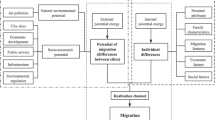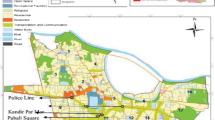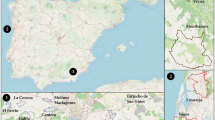Abstract
Many large and industrial cities all around the world suffer from out-migration. It is usually connected with a loss of qualified labour force, suboptimal use of housing and city infrastructure, decrease in investments, etc., resulting in limited development potential. This article investigates the importance of urban environmental quality—especially pollution—for potential out-migration. In addition, it brings two innovative aspects to earlier studies on environmental migration: (a) exploring the influence of subjective perception of pollution, not only its objective level (corresponding to the theory of planned behaviour), (b) examining the different migration strategies instead of one binomial ‘stay or leave’ strategy. A representative sample of 3845 individuals from the city of Ostrava, Czech Republic (the third largest city in the country), which ranks among cities with the most polluted air in the Europe, was used for this purpose. The results suggest that (a) both the quality of natural environment and its subjective perception represent important and highly significant predictors of out-migration intentions, (b) different kinds of pollution lead to different migration strategies, (c) drain of young and educated workers is further strengthened by low quality of the natural environment.



Similar content being viewed by others
Change history
15 June 2021
A Correction to this paper has been published: https://doi.org/10.1007/s00168-021-01065-y
Notes
The annual average level of PM2.5 in the Czech Republic was reported in all its regions up to the level of 35 μg/m3 in 2016 (CZHI, 2016), which corresponds to ‘excellent air quality’ according to the 4-level Chinese national PM2.5 classification (see Li et al. 2017). For an international comparison of air quality in Ostrava, see e.g. IQAir AirVisual (https://www.airvisual.com), which ranked Ostrava, with the mean level of PM2.5 at 30.1 µg/m³, as the 16th most polluted city in Europe in 2018.
As the low employability of the unemployed in Ostrava (approximately 70% of them are unemployed longer than 12 months; Kurník 2018) questions their potential for the development of the city, the analysis focused exclusively on the employed, i.e. productive labour force. Moreover, it can be expected that the migration of unemployed, compared to productive labour force, differs significantly in many important aspects, which might bias the results and their applicability for preventing or even reversing the out-migration of qualified and productive labour force from Ostrava.
References
Adsera A, Pytliková M (2015) The role of language in shaping international migration. Econ J 125(586):F49–F81
Ai Ch, Norton EC (2003) Interaction terms in logit and probit models. Econ Lett 80:123–129
Ajzen I (1991) The theory of planned behavior. Organ Behav Hum Decis Process 50(2):179–211
Ajzen I (2011) The theory of planned behaviour: reactions and reflections. Psychol Health 26(9):1113–1127
Ajzen I, Driver BL (1992) Application of the theory of planned behavior to leisure choice. J Leisure Res 24(3):207–224
Anderlini J (2013) ‘Airpocalypse’ drives expats out of Beijing. Financial Times, April 1, 2013. https://www.ft.com/content/46d11e30-99e9-11e2-83ca-00144feabdc0
Balcar J, Filipová L, Machová Z (2012) Gender wage gap in the Czech Republic: first descriptive analysis based on Survey 2011. Rev Econ Perspect 12(3):151–167
Bandura A (1986) Social foundations of thoughts and action: a social cognitive theory. Prentice-Hall, New York
Blanchflower D, Saleheen J, Shadforth C (2007) The impact of the recent migration from Eastern Europe on the UK Economy. Bank of England external MPC unit discussion paper, no. 17
Cai R, Feng S, Oppenheimer M, Pytliková M (2016) Climate variability and international migration: the importance of the agricultural linkage. J Environ Econ Manag 79:135–151
Cebula RJ, Vedder RK (1973) A note on migration, economic opportunity, and the quality of life. J Region Sci 13(2):205–211
Chen S, Oliva P, Zhang P (2017) The effect of air pollution on migration: evidence from China. NBER working paper, no. 24036
Cheng S, Long JS (2007) Testing for IIA in the multinomial logit model. Sociol Methods Res 35(4):583–600
Chindarkar N (2014) Is subjective well-being of concern to potential migrants from Latin America? Soc Indic Res 115(1):159–182
Chort I (2014) Mexican migrants to the US: What do unrealized migration intentions tell us about gender inequalities? World Dev 59(C):535–552
Conner M, Kirk SF, Cade JE, Barrett JH (2003) Environmental influences: factors influencing a woman’s decision to use dietary supplements. J Nutr 133(6):1978S–1982S
Constant A, Massey DS (2002) Return migration by German guestworkers: neoclassical versus new economic theories. Int Migr 40(4):5–32
CZHI, Czech Hydrometeorological Institute (2016) Graphic yearbook 2016. http://portal.chmi.cz/files/portal/docs/uoco/isko/grafroc/16groc/gr16en/Obsah_GB.html. Accessed 1 Feb 2019
CZSO, Czech Statistical Office (2018) Databáze demografických údajů za obce ČR. https://www.czso.cz/csu/czso/databaze-demografickych-udaju-za-obce-cr. Accessed 1 Feb 2019
DeGolyer ME (2008) Hong Kong’s silent epidemic: public opinion survey on air pollution, environment and public health. http://www.hongkongcan.org/doclib/200901_HongKongsSilentEpidemic.pdf. Accessed 1 Feb 2019
DeJong GF (2000) Expectations, gender and norms in migration decision-making. Popul Stud 54(3):307–319
Dostal M et al (2013) Comparison of child morbidity in regions of Ostrava, Czech Republic, with different degrees of pollution: a retrospective cohort study. Environ Health 12(1):74
Dow JK, Endersby JW (2004) Multinomial probit and multinomial logit: a comparison of choice models for voting research. Elect Stud 23(1):107–122
Feng S, Oppenheimer M, Schlenker W (2012) Climate change, crop yields, and internal migration in the United States. NBER working paper, no. 17734
Fidrmuc J, Huber J (2007) The willingness to migrate in the CEECs. Evidence from the Czech Republic. WIFO working paper no. 286/2007
Fry TRL, Harris MN (1996) A Monte Carlo study of tests for the independence of irrelevant alternatives property. Transp Res Part B Methodol 30(1):19–30
Fry TRL, Harris MN (1998) Testing for independence of irrelevant alternatives: some empirical results. Sociol Methods Res 26(3):401–423
Gödri I, Feleky GA (2017) Selection of migrants and realization of migration intentions—lessons from a panel study. Working papers on population, family and welfare, no. 29
Groenewold G, de Bruijn B, Bilsborrow R (2012) Psychosocial factors of migration: adaptation and application of the health belief model. Int Migr 50:211–231
Guzi M, Mikula S (2018) Reforms that keep you at home: the effects of economic transition on migration. IZA discussion paper series, no. 11369
Hsieh Ch, Liu B (1983) The pursuance of better quality of life: in the long run, better quality of social life is the most important factor in migration. Am J Econ Sociol 42(4):431–440
Huber P, Mikula S (2019) Social capital and willingness to migrate in post—communist countries. Empirica 46(1):31–59
Ivlevs A (2014) Happy moves? Assessing the impact of life satisfaction one migration intentions. Economics working paper series, no. 1402
Kley S (2017) Facilitators and constraints at each stage of migration decision process. Popul Stud 71(sup1):35–49
Koger S, Winter DNN (2010) The psychology of environmental problems. Psychology Press, New York. ISBN 13:978-1848728097
Kropko J (2008) Choosing between multinomial logit and multinomial probit models for analysis of unordered choice data. http://citation.allacademic.com/meta/p265696_index.html. Accessed 1 Feb 2019
Kühn M, Liebmann H (2012) Urban regeneration—strategies of shrinking cities in Eastern Germany. DIE ERDE J Geogr Soc Berlin 143(1–2):135–152
Kurník J (2018) Long-term unemployment in selected municipal part of Ostrava. In: Proceedings of 15th international scientific conference: economic policy in the European Union member countries. VSB—Technical University of Ostrava, Ostrava. ISBN: 978-80-248-4155-7
Li A (2019) Fertility intention-induced relocation: the mediating role of housing markets. Popul Space Place 25:e2265
Li D, Zhang Y, Ma S (2017) Would smog lead to outflow of labor force? Empirical evidence from China. Emerg Mark Finance Trade 53(5):1122–1134
Liu BC (1976) Quality of life indicators in U.S. metropolitan areas, 1970. A comprehensive assessment. Praeger Publishers Inc., New York. ISBN: 027556360X
Lovo S (2014) Potential migration and subjective well-being in Europe. IZA J Migr 3(1):1–18
Lu M (1999) Do people move when they say they will? Inconsistencies in individual migration behaviour. Popul Environ 20(35):467–488
Lu H, Yue A, Chen H, Long R (2018) Could smog pollution lead to the migration of local skilled workers? Evidence from the Jing-Jin-Ji region in China. Resour Conserv Recycl 130:177–187
Lux M, Sunega P (2012) Labour mobility and housing: the impact of housing tenure and housing affordability on labour migration in the Czech Republic. Urban Stud 49(3):489–504
Ma G, Hofmann ET (2018) Immigration and environment in the USA: a spatial study of air quality. The Social Science Journal. https://doi.org/10.1016/j.soscij.2018.08.007in press
Ma G, Hofmann ET (2019) Population, immigration, and air quality in the USA: a spatial panel study. Popul Environ. https://doi.org/10.1007/s11111-018-0311-9in press
Madden TJ, Ellen PS, Ajzen I (1992) A comparison of the theory of planned behavior and the theory of reasoned action. Pers Soc Psychol Bull 18(1):3–9
Maslow AH (1970) Motivation and personality, 2nd edn. Harper and Row, New York
Massey DS, Arango J, Hugo G, Kouaci A, Pellegrino A, Taylor JE (1993) Theories of international migration: a review and appraisal. Popul Dev Rev 19(3):431–466
Masud MM, Al-Amin AQ, Junsheng H, Ahmed F, Yahaya SR, Akhtar R, Banna H (2015) Climate change issue and the theory of planned behaviour: relationship by empirical evidence. J Clean Prod 113:613–623
McFadden D (1974) Conditional logit analysis of qualitative choice behavior. In: Zarembka P (ed) Front Econ. Academic Press, New York
Moss T (2008) Cold spots of urban infrastructure: shrinking processes in Eastern Germany and the modern infrastructural ideal. Int J Urban Reg Res 32(2):436–451
Mueller V, Gray C, Kosec K (2014) Heat stress increases long-term human migration in rural Pakistan. Nat Clim Change 4:182–185
Naudé WA (2009) Natural disasters and international migration from sub-Saharan Africa. Migr Lett 6(2):167–175
Naudé W (2010) The determinants of migration from Sub-Saharan African Countries. J Afr Econ 19(3):330–356
Nguyen MN, Potvin L, Otis J (1997) Regular exercise in 30-to 60-year-old men: combining the stages-of-change model and the theory of planned behavior to identify determinants for targeting heart health interventions. J Commun Health 22(4):233–246
Norton EC, Wang H, Ai Ch (2004) Computing interaction effects and standard errors in logit and probit models. Stata J 4(2):154–167
Ortega F, Peri G (2012) The effect of income and immigration policies on international migration. NBER working paper, no. 18322
Pan L, Zhou Y (2013) International factor mobility, environmental pollution and skilled–unskilled wage inequality in developing countries. Econ Model 33:826–831
Pedersen JP, Pytlikova M, Smith N (2006) Migration into OECD countries 1990–2000. In: Parson CA, Smeeding TM (eds) Immigration and the transformation of Europe. Cambridge, Cambridge University Press. ISBN:9780521861939
Pedersen PJ, Pytlikova M, Smith N (2008) Selection and network effects—Migration flows into OECD countries 1990–2000. Eur Econ Rev 52(7):1160–1186
Price CE, Feldmeyer B (2012) The environmental impact of immigration: an analysis of the effects of immigrant concentration on air pollution levels. Popul Res Policy Rev 31(1):119–140
Quin Y, Zhu H (2018) Run away? Air pollution and emigration interests in China. J Popul Econ 31(1):235–266
Quinn KM, Martin AD, Whitford AB (1999) Voter choice in multi-party democracies: a test of competing theories and models. Am J Polit Sci 43(4):1231–1247
Rumpel P, Slach O (2012) Governance of shrinkage of the city of Ostrava. European Science and Art Publishing, Praha. ISBN 978-80-87504-19-2
Rumpel P, Slach O, Koutský J (2013) Shrinking cities and governance of economic regeneration: the case of Ostrava. Ekonomie Manag 16(2):113–128
Schilling J, Logan J (2008) Greening the rust belt: a green infrastructure model for right sizing America’s Shrinking cities. J Am Plan Assoc 74(4):451–466
Sheeran P, Taylor S (1999) Predicting intentions to use condoms: a meta-analysis and comparison of the theories of reasoned action and planned behavior. J Appl Soc Psychol 29:1624–1675
Silverman RM, Yin L, Patterson KL (2012) Dawn of the dead city: an exploratory analysis of vacant addresses in Buffalo, NY 2008–2010. J Urban Affairs 35(2):131–152
Simpson NB (2013) Happiness and migration. In: Zimmermann KF, Constant AF (eds) International handbook on the economics of migration. Edward Elgar Publishing Limited, Cheltenham. ISBN 978-1-84542-629-3
Squalli J (2009) Immigration and environmental emissions: a U.S. county-level analysis. Popul Environ 30(6):247–260
Squalli J (2010) An empirical assessment of U.S. state-level immigration and environmental emissions. Ecol Econ 69(5):1170–1175
Šrám R et al (2013) Health impact of air pollution to children. Int J Hyg Environ Health 216(5):533–540
Stern PC (2005) Understanding individuals’ environmentally significant behavior. Environ Law Rep News Anal 35(11):10785–10790
Stigler GJ (1961) The economics of information. J Polit Econ 69(3):213–225
Šulák J (2019) Dopad znečištění životního prostředí na migraci. Dissertation thesis, VSB—Technical University of Ostrava, Czech Republic
Van Dalen HP, Henkens K (2013) Explaining Emigration Intentions and Behaviour in the Netherlands, 2005–10. Popul Stud 67(2):225–241
Welsch H (2002) Preferences over prosperity and pollution: environmental valuation based on happiness surveys. Kyklos 55(4):473–494
Winter-Ebmer R (1994) Motivation for migration and economic success. J Econ Psychol 15(2):269–284
Xu X, Sylwester K (2016) Environmental quality and international migration. Kyklos 69(1):157–180
Zhang P (2019) Skill formation, environmental pollution, and wage inequality. Ann Reg Sci 62:405–424
Acknowledgements
This research was supported by Faculty of Economics, VSB—Technical University of Ostrava within SGS Research Grant ‘The role of migration and knowledge economy for developing and emerging economies’ (No. SP2018/151).
Author information
Authors and Affiliations
Corresponding author
Ethics declarations
Conflict of interest
The authors declare that they have no conflict of interest.
Additional information
Publisher's Note
Springer Nature remains neutral with regard to jurisdictional claims in published maps and institutional affiliations.
Electronic supplementary material
Below is the link to the electronic supplementary material.




